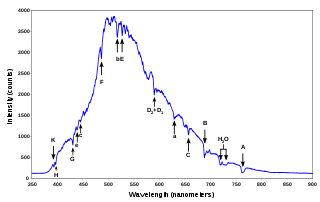Diffuse sky radiation

Diffuse sky radiation is solar radiation reaching the Earth's surface after having been scattered from the direct solar beam by molecules or suspensoids in the atmosphere. It is also called skylight, diffuse skylight, or sky radiation and is the reason for changes in the color of the sky. Of the total light removed from the direct solar beam by scattering in the atmosphere (approximately 25% of the incident radiation when the sun is high in the sky, depending on the amount of dust and haze in the atmosphere), about two-thirds ultimately reaches the earth as diffuse sky radiation.
The important processes in the atmosphere (Rayleigh scattering and Mie scattering) are elastic processes, by which light can be deviated from its path without being absorbed and with no change in wavelength.
Color


The sunlit sky is blue because air scatters short-wavelength light more than longer wavelengths. Since blue light is at the short wavelength end of the visible spectrum, it is more strongly scattered in the atmosphere than long wavelength red light. The result is that the human eye perceives blue when looking toward parts of the sky other than the sun.[1] The color perceived is similar to that obtained by a monochromatic blue of wavelength 474–476 nm mixed with white light, i.e., an unsaturated blue light.[2]
Near sunrise and sunset, most of the light we see comes in nearly tangentially to the Earth's surface, thus the light's path through the atmosphere is so long that much of the blue and even green light is scattered out, leaving the sun rays and the clouds it illuminates red. Therefore, when looking at the sunset and sunrise, you will see the color red more than any of the other colors.
Near sunrise and sunset, most of the light we see comes in nearly tangentially to the Earth's surface, thus the refraction of lights becomes stronger. But the refraction angle of light with small wavelength (blue) is bigger than light with big wavelength (red). Therefore, small wavelength light will be filtered out, when the sun gradually falls down or rises up. Therefore, when looking at the sunset and sunrise, you will see the color red more than any of the other colors.
Scattering and absorption are major causes of the attenuation of radiation by the atmosphere. Scattering varies as a function of the ratio of the particle diameter to the wavelength of the radiation. When this ratio is less than about one-tenth, Rayleigh scattering occurs in which the scattering coefficient varies inversely as the fourth power of the wavelength. At larger values of the ratio of particle diameter to wavelength, the scattering varies in a complex fashion described, for spherical particles, by the Mie theory; at a ratio of the order of 10, the laws of geometric optics begin to apply.
In the example of the sky at the zenith, it is blue during broad daylight due to Rayleigh scattering involving diatomic gases (N2, O2). Near sunset and especially during twilight, ozone (O3) absorption significantly contributes to maintaining the blue sky color.
Neutral points
There are four commonly detectable points of zero polarization of diffuse sky radiation (known as neutral points) lying along the vertical circle through the sun.
- The Arago point, named after its discoverer, is customarily located at about 20° above the antisolar point; but it lies at higher altitudes in turbid air. The latter property makes the Arago distance a useful measure of atmospheric turbidity.
- The Babinet point, discovered by Babinet in 1840, is located about 15° to 20° above the sun, hence it is difficult to observe because of solar glare.
- The Brewster point, discovered by Brewster in 1840, is located about 15° to 20° below the sun; hence it is difficult to observe because of solar glare.
- The fourth point, located at about 20° below the antisolar point, visible only at higher altitudes in the air or space[3]
Under an overcast sky
There is essentially no direct sunlight under an overcast sky, so all light is then diffuse sky radiation. The flux of light is not very wavelength dependent because the cloud droplets are larger than the light's wavelength and scatter all colors approximately equally. The light passes through the translucent clouds in a manner similar to frosted glass. The intensity ranges (roughly) from 1⁄6 of direct sunlight for relatively thin clouds down to 1⁄1000 of direct sunlight under the extreme of thickest storm clouds.
See also
- Atmospheric diffraction
- Aerial perspective
- Cyanometer
- Daylight
- Nighttime airglow
- Tyndall effect
- Rayleigh scattering
- Rayleigh Sky Model
References
- ↑ "Rayleigh scattering." Encyclopædia Britannica. 2007. Encyclopædia Britannica Online. 16 Nov. 2007.
- ↑ "Human color vision and the unsaturated blue color of the daytime sky", Glenn S. Smith, American Journal of Physics, Volume 73, Issue 7, pp. 590-597 (2005).
- ↑ Horváth G, Bernáth B, Suhai B, Barta A, Wehner R.: First observation of the fourth neutral polarization point in the atmosphere, J Opt Soc Am A Opt Image Sci Vis. 2002 Oct;19(10):2085-99.
Further reading
- Pesic, Peter (2005). Sky in a Bottle. The MIT Press. ISBN 978-0-262-16234-0.